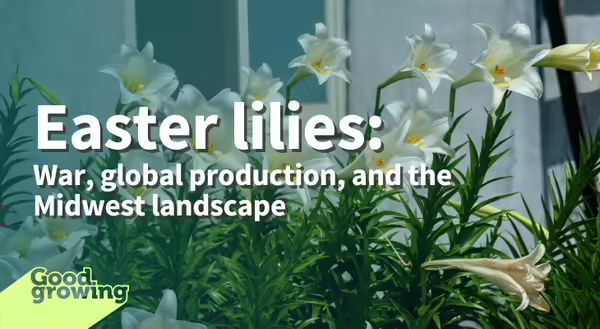
In addition to the spring flowers blooming outside, many enjoy the fragrant flowers of a Lilium longiflorum (Easter lily) as a symbol of spring and the Christian holiday Easter. Growers manipulate the growth cycle and force them to bloom so that we can enjoy these blooming beauties during a Midwestern spring. As Easter lily blossoms fade, the weather is warming up, and garden season is quickly approaching. This provides a unique opportunity to transplant forced Easter lilies into the landscape.
Origin story
Native to a small chain of islands in southern Japan and Taiwan known as the Ryuku Archipelago, the species has a long history of cultivation and distribution in the region. In 1777, Swedish-born naturalist and explorer Carl Peter Thunberg traveled to the region and is given credit for learning of the plant. Thunberg first introduced it to England in 1819, and the popularity of the Easter lily expanded worldwide. By the early 21st century, production for a global market was centered in Japan and the southern United States. During World War II, Japan was cut off as a supplier, resulting in increased value as supply became limited. In response, growers in the United States expanded.
Easter lily production
Today, the number of U.S. growers has contracted from approximately 1200 at the height of production to ten producers. Known as the “Easter Lily Capitol of the World”, the United States bulb production industry is centered in the Smith River Valley region of southwestern Oregon and northwestern California, where approximately 600 acres of land are dedicated to Easter lily bulb production.
Producing Easter lilies is a time-consuming process that requires meticulous planning and management to have blooms ready in time for Easter. This task is made even more challenging due to the date of Easter changing each year based on the lunar calendar as it relates to the spring equinox (the first Sunday after the first full moon that is on or after the spring equinox).
Before bulbs are shipped to greenhouses across the country, growers invest two to three years in their development. Scales are specialized leaves that are attached to the basal plate of a mature bulb. When separated and given time and resources to grow, they will develop into larger bulbs in a few years. Each autumn, growers plant fields full of Easter lily scales or small bulbs. During the following year, the plants grow and advance bulb development. Each summer, growers dig the crop and sort the bulbs. Those large enough for commercial sale are packed and sold to greenhouse managers; the others will be replanted to grow another year.
The final stage of growing Easter lilies for the public begins twenty-three weeks prior to Easter. During this time, bulbs are cooled at 40 to 45 degrees F for six weeks to accumulate 1,000 hours of vernalization. This cooling period triggers flower initiation. Once flower initiation is guaranteed, greenhouse managers carefully control the growing environment, including lighting, temperature, humidity, nutrition, watering, and pest control until blooms are ready for the retail market.
Throughout the production process, growers face challenges from soil-borne fungi, bacteria, and nematodes, freezing temperatures, rodent predation, and more. Nematodes provide the greatest challenge to production, and growers have developed multifaceted methods for control.
Planting Easter lilies outdoors
In the Midwest, it is possible to transplant Easter lily bulbs into the perennial landscape if a few precautions are taken. First, once the bloom has faded following the Easter holiday, place the plant in a sunny window until late May. Continue to support plant health by providing water when needed and fertilizing with a diluted solution once every two weeks.
Easter lilies may be planted outdoors after the risk of frost has passed. Choose a sunny location with well-drained soil. Choose a sheltered location that is protected from strong winds that could damage the blooms.
Plant bulbs six inches deep and apply a wood mulch. Easter lilies planted after being forced to bloom will die back in early summer. Remove the spent stem and continue plant care, the lily will produce new growth throughout the summer. The plant is not expected to rebloom in the first year, although some may.
Long-term care of the plant includes ensuring adequate moisture is available without waterlogging the soil, feeding the bulb with a balanced fertilizer if a soil test indicates deficiencies, and maintaining mulch to retain soil moisture and prevent weeds. Spent blooms should be removed so plant energy can be directed toward bulb development rather than seed production.
Easter lilies are marginally hardy in the Midwest, hardy in zones 5 to 11, and therefore require extra winter protection. Apply a thick layer of mulch or straw late in the autumn for additional insulation. If temperatures are expected to drop severely, consider providing an extra level of protection by covering with burlap or another protective material. Remove the extra protection once temperatures have recovered.
Good Growing Fact of the Week: Easter lilies and other lilies are poisonous to cats and can cause kidney failure. Call your veterinarian immediately if it is suspected that a cat has consumed a part of the plant.
Thank you for reading!
Sign up for our emails! Want to get notified when new Good Growing posts are available? SIGN ME UP
Give us feedback! How helpful was this information (click one): Very helpful | Somewhat helpful | Not very helpful
MEET THE AUTHOR
Emily Swihart is a horticulture educator with University of Illinois Extension, serving Henry, Mercer, Rock Island, and Stark counties since 2021. Emily provides horticulture programming with an emphasis on the home gardener, the urban forest, native plant ecosystems, and landscape design. Additional responsibilities include supporting local county Master Gardener and Master Naturalist volunteers - providing training, continuing education, advanced training, and their involvement in seasonal events and community outreach programs.